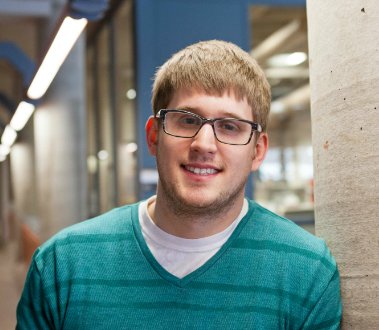Student Profile: Noah Kimmes (GeoE, May 2014)

We all find our own way through life - and through college. Three graduates illustrate three successful, albeit different, paths through a civil engineering education at the University of Minnesota. Steven Borntrager made an effort to connect with students and involve himself in on-campus activities. Kathryn Klarich sought out opportunities to travel, and Noah Kimmes aimed for graduate school.
Noah Kimmes (GeoE, May 2014) came from the Upper Peninsula of Michigan to go to school in the big city. He completed his preliminary coursework at Anoka-Ramsey Community College before transferring to UMN.
“My dad pushed for me to go into engineering because I was always good at math and science. When I found the UMN Geoengineering program I found a way to put my abilities and my passion, geology, into real world applications.”
“Geoengineering is one of the coolest majors anyone could do. It is a great, great major and more people should know about it. I got to meet two totally different groups of people— civil engineering people and geology people—and take classes with each of them.”
Noah noted a significant difference between the two fields. “The geology classes seem more theoretical and engineering more practical, although there is a balance in each. In geology a lot of theories cannot be proven in the same way that things can be tested in engineering. We cannot travel to the center of the earth. Most problems in engineering, however, can be tested with research.”
“Rock mechanics was the class I was most looking forward to when I started the program. Professor Joseph Labuz taught us the theory, and then Dr. Lee Peterson (PhD ‘91), from Itasca Engineering, came in and talked about projects he worked on, kinds of rock bolts, and excavations and tunnels. Professor Labuz also taught Soil Mechanics 2 with the same sort of set-up: he taught us Mohr’s Circle and stress and strain of soils and retaining walls. Then Derrick Dasenbrock, Foundations LRFD Engineer from MnDOT, came in to talk about deep and shallow foundations and slope stability. Labuz is very passionate about what he likes, very bright, and willing to help. It’s great when a teacher really likes teaching and likes what he’s talking about.”
“Computer Applications 2 with Professor Barnes was another great class—really challenging but really rewarding. The homework was hard so I had to go see him. I would have spent countless hours trying to figure out something that required just a little bit of guidance. Through that experience, I discovered the value of office hours. If you show interest in something, professors are very willing to help you and get you involved in what they are doing. It is much easier to get them to respond than I thought. And I discovered how helpful they can be with the job search!”
“My advisor is Associate Professor Kimberly Hill. I am working with her on an Undergraduate Research Opportunities Program (UROP) project about debris flow. I have been using different water and glycerin formulas to model the effects of different viscosities of the interstitial fluid. We use the flume in the Fluid Mechanics Lab for modeling. It’s been pretty cool.
For his Capstone project, Noah and his team are working on the expansion for a sand processing plant, which is Noah’s first exposure to structural engineering. He will be working on the foundational design and getting exposure to another new area of engineering.
Noah has been applying his education in his job with MnDOT, where he started as a Student Worker in May of 2013. “I work in the Research Office Design Group. I do a lot of lab work related to asphalt research, which is something I did not see myself getting into as a geoengineer—but you never know!”
He will work with MnDOT through the summer and plans to attend graduate school in the fall. Noah has been looking at three pretty different options for his continued studies, all stemming from his experiences in the GeoE program. If he were to continue his studies at UMN, he would be interested in studying rock mechanics with Professor Labuz or possibly continuing asphalt research under Professor Lev Khazanovich. His Rock Mechanics class ignited an interest in pursuing a degree in Underground Construction and Tunneling at the Colorado School of Mines. That program combines civil, mining, and geological engineering. His UROP project led him to the possibility of studying slope stability related to forest management. He has considered the possibility of pursuing that interest at Oregon State University.
“I have a lot of interests and I just have to narrow it down.”
Update: Noah will be attending the Colorado School of Mines in the Fall of 2014.